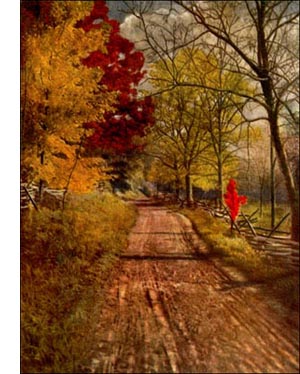Scrub Pine Tree
 The Scrub Pine (P. contorta, Lond.) is one of four stunted, gnarly, round-shouldered trees that are prostrated by exposure to the ocean winds. They are the beach pines. This one grows from northern California into Alaska in bogs and sand dunes, bearing its cones when only a few inches high in the bleakest situations. These trees form a windbreak behind which many sorts of tender plants thrive in quiet security. The bark is thin and pale and gummy on these dwarfs, and once a fire is started it devours all within reach. Now a very interesting habit of the tree comes into prominence. The cones hang on the trees for years without opening, but their seeds are safely sealed up and retain their vitality. The burned trees drop their cones, which, opening, free the seeds. From them young trees spring up to take the places of those wiped out by the fire.
The Scrub Pine (P. contorta, Lond.) is one of four stunted, gnarly, round-shouldered trees that are prostrated by exposure to the ocean winds. They are the beach pines. This one grows from northern California into Alaska in bogs and sand dunes, bearing its cones when only a few inches high in the bleakest situations. These trees form a windbreak behind which many sorts of tender plants thrive in quiet security. The bark is thin and pale and gummy on these dwarfs, and once a fire is started it devours all within reach. Now a very interesting habit of the tree comes into prominence. The cones hang on the trees for years without opening, but their seeds are safely sealed up and retain their vitality. The burned trees drop their cones, which, opening, free the seeds. From them young trees spring up to take the places of those wiped out by the fire.It is hard to believe that the tall, slim lodge pole, or tamarack pine is but a variety-Murrayana-of P. contorta, but so it is considered on good authority. The mountains of Wyoming, Colorado and the states further west are clothed with dense forests of this tree. They grow as thick as wheat in a field, and so are all delicately tall, but in favoured situations isolated trees reach the height of 100 feet, and a trunk diameter of 1 1/2 feet. An average forest specimen is 5 inches through and 40 to 5o feet high. The Indians cut poles for their lodges or tepees. These pines, flexible, slender and always abundant, seemed designed by Nature to serve this need. The name remains, though the lodge of the Indian is rapidly disappearing.
There is great variation in this species and its variety, Murrayana, as the trees meet very different conditions. The leaves are in twos, and I to 3 inches long, dark green in contorta, yellow-green and quite wide in the variety. The wood of contorta is hard, brownish red, and strong; of Murrayana, soft, pale yellow, and weak. The latter is used for lumber to a limited extent, and both are cut for fuel. While it is not a prominent commercial tree, it is the main reliance of the pioneer in many regions. It supplies mines with supporting beams, fences the settler's homestead, and furnishes ties for the pioneer railroads.
The Indians cut the trees down and strip out the inner bark. This is broken into pieces by the patient squaws, who mash it in water into a pulp which they mould into large cakes. Then a hole is dug in the ground and lined with stones, and a fire kindled. When the stones are hot the embers are removed, and the cakes packed in with leaves of the Western skunk cabbage between. A fire of damp moss is built on top, and the baking takes an hour or more. Then the cakes are laid on slat frames and smoked for a week in a close tent. Now they are ready to put away for future use, or to carry in canoes or on ponies to distant places.
This " hard bread " is prepared for use by breaking it in pieces and boiling them until soft. The pieces are skimmed out and laid on the snow to cool. " Ulikou " fat is used on this strange Alaskan bread as we use butter.
The Indians make berry baskets out of the bark of the lodgepole pine. Nuttall, in his extension of Michaux's "Sylva of North America," calls this the twisted-branched pine. I well recall the curious rustic chairs and seats at the Dome Lake Club House in the Big Horn Mountains in Wyoming, made of the extravagantly twisted branches of this tree. They called it -screw pine," I remember. The name contorta, may allude to this characteristic, too, although it is not constant in the species. It may rather be regarded as a freak of nature, the cause of which is not understood. However, the hard life of the species on the bleak, wind-swept coast and unprotected sand dunes may easily earn it the name there.